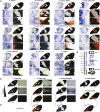Diversification of complex butterfly wing patterns by repeated regulatory evolution of a Wnt ligand
- PMID: 22802635
- PMCID: PMC3411988
- DOI: 10.1073/pnas.1204800109
Diversification of complex butterfly wing patterns by repeated regulatory evolution of a Wnt ligand
Abstract
Although animals display a rich variety of shapes and patterns, the genetic changes that explain how complex forms arise are still unclear. Here we take advantage of the extensive diversity of Heliconius butterflies to identify a gene that causes adaptive variation of black wing patterns within and between species. Linkage mapping in two species groups, gene-expression analysis in seven species, and pharmacological treatments all indicate that cis-regulatory evolution of the WntA ligand underpins discrete changes in color pattern features across the Heliconius genus. These results illustrate how the direct modulation of morphogen sources can generate a wide array of unique morphologies, thus providing a link between natural genetic variation, pattern formation, and adaptation.
Conflict of interest statement
The authors declare no conflict of interest.
Figures



References
-
- Wolpert L. Positional information and the spatial pattern of cellular differentiation. J Theor Biol. 1969;25:1–47. - PubMed
-
- Salazar-Ciudad I, Jernvall J, Newman SA. Mechanisms of pattern formation in development and evolution. Development. 2003;130:2027–2037. - PubMed
-
- Carroll SB, Grenier JK, Weatherbee SD. From DNA to Diversity: Molecular Genetics and the Evolution of Animal Design, Second Edition. Malden, MA: Blackwell Scientific; 2004.
-
- Wilkins AS. The Evolution of Developmental Pathways. Sunderland: Sinauer Associates; 2002.
-
- Stern DL. Evolutionary developmental biology and the problem of variation. Evolution. 2000;54:1079–1091. - PubMed
Publication types
MeSH terms
Substances
Associated data
- Actions
- Actions
- Actions
- Actions
- Actions
- Actions
- Actions
- Actions
- Actions
- Actions
Grants and funding
LinkOut - more resources
Full Text Sources

